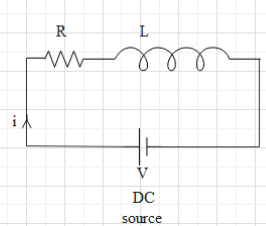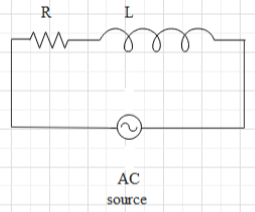The full form of DC is direct current. It is the current flowing in the circuit with a constant potential difference. If the resistance of the circuit is \(R\), the voltage of the \(D C\) source (e.g. a battery) is \({V}\), then the relation between \({V}, {R}\) and the current i flowing in the circuit is given by ohm's law i.e.,
\(V=i R\) Consider the circuit as shown below:

It is given that the voltage of the DC source is \(100\) volt and the current flowing in the circuit is 1 amp, so the resistance \(R\) of the circuit, according to ohm's law will
\(R=\frac{V}{i}=\frac{100}{1}=100 \Omega\). Therefore, the given circuit,
Which consists of a solenoid has a resistance of \(100 \Omega\).
The full form of \(A C\) is alternating current. When a source produces an oscillating potential difference across the circuit, an alternating (oscillating current) flows in the circuit and this type of circuit is called an AC circuit. Since it is an oscillating circuit, it has a frequency (f).
Now consider an AC circuit as shown below:

Like in a DC circuit, there is resistance (R) to resist the flowing charges (electrons), in an AC circuit also there is a resistance called impedance \((Z)\). The relation between the potential difference (V), current (i) and the impedance (Z) of the circuit is \(V=i Z\)......(1)
Therefore, impedance has the same unit as resistance i.e. \(\Omega\)
If the circuit consists of an inductor (solenoid) of inductance \(L\) and ha some resistance \(R\), then the impedance of the \(A C\) circuit is \(Z=\sqrt{R^{2}+(\omega L)^{2}}\)........(2)
Let us now calculate the impedance of the circuit. From equation (1) we know
\(Z=\frac{V}{i}\)
Therefore,
\(Z=\frac{100}{0.5}=200 \Omega\)
Since, the same solenoid is the resistance of the circuit will be the same. Hence, \(R=100 \Omega\). Substitute the values of \(Z\) and \(R\) in equation (2).
\(\Rightarrow 200=\sqrt{(100)^{2}+(\omega L)^{2}} \)
\(\Rightarrow 40000=(100)^{2}+(\omega L)^{2} \)
\(\Rightarrow 40000=10000+(\omega L)^{2}\)
Therefore,
\(\omega L=\sqrt{30000}=173.2 \Omega\)
We know \(\omega=2 \pi f\)
\(f=50 H z\) and \(\pi=3.14\).
This implies that:
\(\omega=2 \times 3.14 \times 50=314 {~s}^{-1}\)
\(\therefore L=\frac{173.2}{314}=0.55 H\).


 Get latest Exam Updates
Get latest Exam Updates 
 ×
×
















